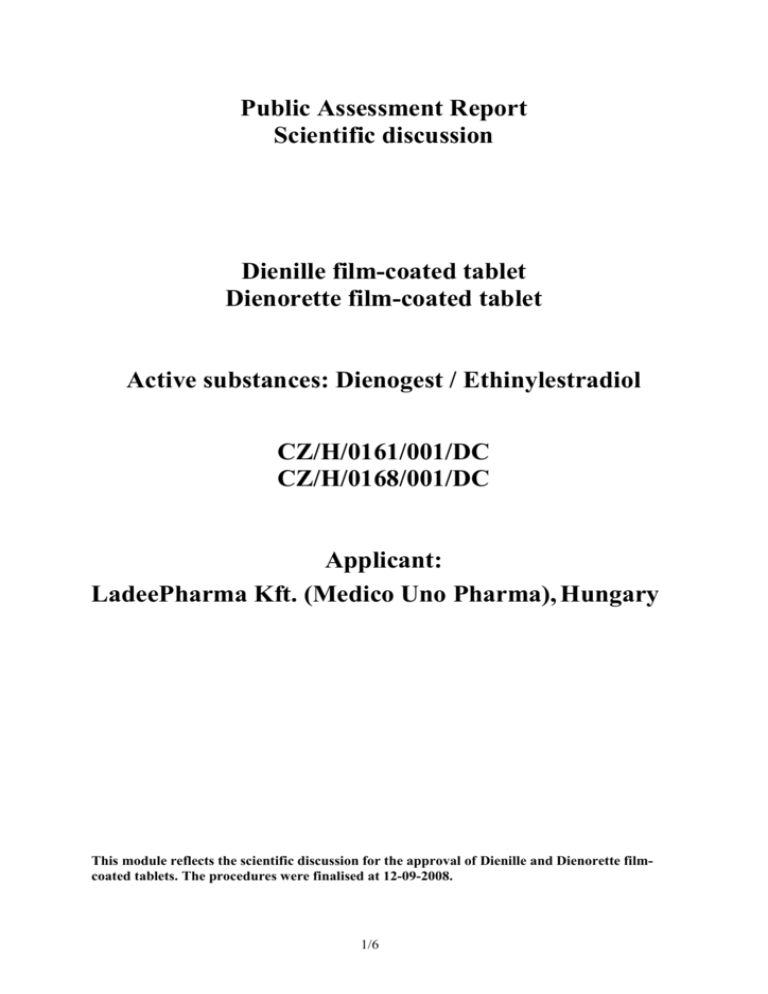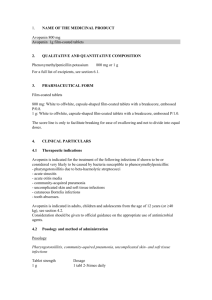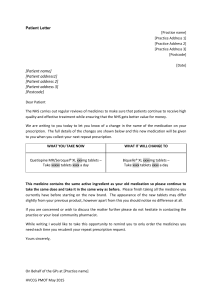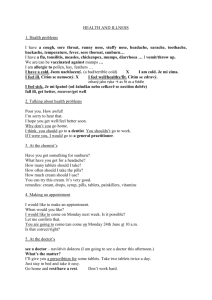Day 120 LoQ template
advertisement

Public Assessment Report Scientific discussion Dienille film-coated tablet Dienorette film-coated tablet Active substances: Dienogest / Ethinylestradiol CZ/H/0161/001/DC CZ/H/0168/001/DC Applicant: LadeePharma Kft. (Medico Uno Pharma), Hungary This module reflects the scientific discussion for the approval of Dienille and Dienorette filmcoated tablets. The procedures were finalised at 12-09-2008. 1/6 INTRODUCTION This decentralised procedures concern a generic version of Dienogest 2.00 mg/ Ethinylestradiol 0.030 mg film-coated tablets. The originator product Valette tablet by Jenapharm GmbH CoKG, Germany has been registered in Germany since March 1995. The applications are submitted in accordance with Directive 2004/83/EC Article 10(1) generic application. With the Czech Republic as the Reference Member State in the Decentralised Procedure CZ/H/161/01/DC, MedMR Kft., Biatorbágy, Hungary (proposed MAH has changed - new company name LadeePharma Kft.) is applying for the Marketing Authorisation for Dienille in the following Concerned Member States: Austria, Bulgaria, Romania, Slovak Republic and Slovenia. In Austria was the MA transferred to Ratiopharm thereafter. With the Czech Republic as the Reference Member State in the Decentralised Procedure CZ/H/168/01/DC, Laboratorios León Farma SA, León, Spain is applying for Marketing Authorisation for Dienorette in the following Concerned Member States: Belgium, Estonia, France, Italy, Latvia, Lithuania, Luxembourg, Portugal and Spain. Dienille film-coated tablets and Dienorette film-coated tablets are fixed-combination tablets which combine two active substances – Ethinylestradiol and Dienogest. It is indicated in women as oral hormonal contraceptive and for the treatment of moderately severe acne. The legal basis of this application is Article 10.2 (b) so called “generic application” of Directive 2001/83/EC, as amended. The product concerned claims essential similarity to the reference product Valette tablets. QUALITY ASPECTS Introduction Dienille and Dienorette are presented in the form of film-coated tablets containing 2 mg Dienogestum and 0.03 mg Ethinylestradiolum. The excipients are Lactose monohydrate, Magnesium stearate, Maize starch, Povidon 30, Talc and film coating Opaglos 2 clear, containing Croscarmellose sodium, Glucose, Maltodextrin, Sodium citrate dihydrate and Soya lecithin. The choice and function of the excipients have been satisfactorily described. The product is packed into PVC/PVDC/Aluminium blisters. Blisters are placed, together with a package leaflet, into a paper folding box. Based on the provided stability data, the approved shelf life is 36 months without any special storage conditions. Drug substance Dienogest is not described in the European Pharmacopoeia. The documentation for this active substance is presented as an EDMF. Generally, acceptable data have been provided and they demonstrate quality of the active substance from this source satisfactorily. Letter of Access was presented including the confirmation from the manufacturer of the active substance. All of the analytical tests used have been satisfactorily described. Most tests are performed according to standard methods described in the Ph.Eur. Appropriate discussion has been presented on impurities including residual solvents. 2/6 The specifications applied by the drug product manufacturer for the control of the drug substance have been provided. The substance is packed in a double polyethylene antistatic bag sealed with a numbered nonreusable plastic string seal and then inserted into aluminium drums. The closure of the aluminium drum is air tight. Stability studies have been performed with the drug substance. No significant changes in any parameters were observed. The proposed retest period of 3 years is justified. Ethinylestradiol is described in the European Pharmacopoeia. Two sources of this active substance are used. The documentation for Ethinylestradiol from one of the manufacturers is presented in an EDMF. Generally, acceptable data have been provided and they demonstrate quality of the active substance from this source satisfactorily. The specification is in accordance with the Ph.Eur. monograph for Ethinylestradiol. All methods are adequately described. The substance is packed in a polyethylene antistatic bag tied with a string: this bag is placed into another polyethylene antistatic bag sealed with a numbered non-reusable plastic string and then into an aluminium drum. Silica gel in bags is placed between the polyethylene bags and the aluminium drum. The proposed retest period of 2 years is considered acceptable. At this moment API from this supplier is not used in the manufacture of Laboratorios Leon Farma. The commitments stating that all information from the finished product manufacturer will be provided in case this substance will be used, are included. The other manufacturer of Ethinylestradiol has obtained a CEP which is presented in the file. The Letter of Access was presented including the confirmation from the manufacturer of the active substance. Generally acceptable data have been provided and demonstrate satisfactorily the quality of active substance from this source. The specifications applied by the drug product manufacturer for the control of the drug substance are provided. The drug product manufacturer submitted the certificate of analysis for three batches of the drug substance. The retest period of the substance of 5 years if stored in two polyethylene bags sealed inside a polyethylene container is justified. Medicinal Product Dienille and Dienorette exist as film-coated tablets. The qualitative and quantitative composition is detailed for the core and the film-coating. All excipients except film coating Opaglos 2 clear are common pharmaceutical grade products covered by Ph.Eur. monographies. Satisfactory Certificates of Analysis of all excipients have been provided. Information about composition and in house specification for film coating Opaglos 2 clear are presented in dossier. Specifications and methods of analysis are provided. The only material of animal origin is lactose monohydrate and it is manufactured in compliance with CPMP guideline. Magnesium stearate is derived from a vegetable source. Pharmaceutical development The development of the medicinal product has been sufficiently described; the essential similarity, based on comparison of dissolution profiles and bioequivalence with brand leader Valette, has been documented. Manufacturing of the product 3/6 The manufacturing process can be considered as standard. The manufacture and in-process controls are fully described in the dossier. Results of process validation have been submitted. It may be concluded that the manufacturing process has been shown to be reliable and capable of consistently producing a product that complies with pre-established quality and specifications. Product specification The product specifications cover appropriate parameters for this dosage form. Analytical methods have been satisfactorily described and validated in accordance with regulatory requirements. Limits for related substances comply with ICH guidelines. The batch analysis results show that the finished product meets the specifications proposed. Container closure system The immediate packaging material is a blister made of PVC/PVDC/Aluminium. Satisfactory specifications for blister and certificates of analysis have been provided. The packaging material complies with Ph.Eur. and EU directives. Stability The conditions used in the stability studies correspond to the ICH stability guideline. The control tests and specifications for drug product are adequately drawn up. All stability results meet the set specification. The proposed shelf-life of 36 months without any special storage conditions for the drug product is fully acceptable. Discussion on chemical and pharmaceutical aspects Information on development, manufacture and control of the drug substance and drug product has been presented in a satisfactory manner. The results of tests carried out indicate satisfactory consistency and uniformity of important product quality characteristics, and these in turn lead to the conclusion that the product should have a satisfactory and uniform performance in the clinic. CLINICAL ASPECTS Based on the review of data on quality, safety and efficacy, the RMS considered that the application for Dienorette film-coated, indicated in woman as oral hormonal contraceptive, could be approved. This is a generic application submitted under Article 10(1) of Directive 2001/83/EC. The originator product Valette tablet by Jenapharm GmbH CoKG, Germany has been registered in Germany since March 1995. The contraceptive effect of monophasic combination of Dienogest 2.00 mg/ Ethinylestradiol 0.030 mg is bases on the interactions of various factors. Via negative feedback mechanism on hypothalamus is suppressed the secretion of folliclestimulating hormone and luteinizing hormone by the anterior pituitary. It is followed by the inhibition of ovulation and the changes in the cervical secretion. Furthermore, the endometrium is rendered unreceptive to implantation. In addition both active compounds may also inhibit sperm motility. No new preclinical studies and no clinical studies were conducted, which is acceptable given that the applications were based on essential similarity to a product that has been licensed for more than 10 years. The application contains an adequate review of published clinical data. 4/6 The SmPC of the product Dienorette film-coated tablets corresponds with SmPC of reference product Valette and is in compliance with the latest pharmacovigilance information. The Package leaflet has been shown to provide the tested consumers with all required information in a clear and comprehensive form and the Readability testing was performed according to the guidelines. To prove the essential similarity of the developed film-coated tablets, two bioequivalence studies with two preparations containing Dienogest 2.00 mg/ Ethinylestradiol 0.030 mg: Leon Farma Laboratories formulation (manufactured in Spain) and Vallete (manufactured by Jenapharm, Germany), were performed. The first one (Protocol No.DIE-PBE-01-LIC/04) was a pilot two period cross-over, controlled, randomized, single dose bioequivalence study in 10 healthy female volunteers under fasting conditions with wash-out period one menstrual cycle. Ten healthy, non-smoking Caucasian women between 18 and 44 years of age were enrolled into the study when fulfilling inclusion criteria and not fulfilling any of exclusion criteria as specified in the study protocol. Subject 1 was drop-out due to vomiting which occurred 5 hours after the drug administration in Phase 2 of the study. All female entered the trial were statistically analyzed for their demographic and safety data. Descriptive statistics were performed for age, height, weight and BMI. A number of 9 subjects were evaluated in the pharmacokinetic data analysis. Mean age of the analysed 10 female was 30.00 ± 9.67 years; mean height 166.9 ± 5.4 cm; mean weight 63.5 ± 10.1 kg; and mean BMI 22.74 ± 3.00 kg/m2. Subjects were instructed to avoid beverages containing grapefruit for 7 days and abstain from alcohol, food and beverages containing xanthenes and poppy seeds or from fruit juices for 48 hours prior to the administration. Following a minimum of 10-hour fasting each volunteer received in the day 3 to 7 of the current menstrual cycle, in a random way, a single oral dose of the Test or Reference formulation with 240 mL low carbonated water. Subjects were hospitalized until 24 hours post administration. Then they visited the study centre at scheduled time intervals. About 5 mL venous blood samples were drawn in labeled tubes containing heparin as anticoagulant at pre-defined sampling time up to 96 hours post-dose. The concentration of ethinylestradiol/dienogest was determined using HPLC-MS/MS. Lower limits of quantitation (LLOQ) were 1.5 ng/mL for dienogest and 5.0 pg/mL for ethinylestradiol. Systemic levels below the LLOQ were set to 0.00. ANOVA was carried out on log transformed AUC0-last, AUC0-∞, Cmax values and 90% confidence intervals were calculated. The treatment, period, sequence and subject in sequence terms were included in the model. Computer output corresponds with that model. In the present study occurred fifteen not serious adverse events (AE) of mild to moderate intensity in three subjects. There were reported 9 AE on Test (3x headache, 1x nausea, 4x vomiting, 1x agitation) vs. 6 on Reference product (2 headache, 1x nausea, 1x edema, 1x strong and extended menses and 1x dim sight and problems with visibility). All the volunteers completely recovered before the end of the study. Results: The 90% confidence intervals of Cmax and AUC0-t ratios were completely inside the accepted bioequivalence range set by the protocol (0.80-1.25). 5/6 The second one (Protocol No.DIE-BESD-02-LIC/05) was a pivotal two period cross-over, controlled, randomized laboratory blind, single dose bioequivalence study in 28 healthy female volunteers under fasting conditions with wash-out period of 28 days. Twenty eight healthy, non-smoking Caucasian women between 18 and 44 years of age were enrolled into the study when fulfilling inclusion criteria and not fulfilling any of exclusion criteria as specified in the study protocol. There were no drop out/withdrawn subjects and thus all of 28 females, who were enrolled, completed the study and were analyzed. Mean age of the analysed 28 female was 25.71 ± 7.9 years; mean height 164.93 ± 6.74 cm; mean weight 60.71 ± 7.75 kg; and mean BMI 22.33 ± 2.68 kg/m2. Subjects were instructed to avoid beverages containing grapefruit for 7 days and abstain from alcohol, food and beverages containing xanthenes and poppy seeds or from fruit juices for 48 hours prior to the administration. Following a minimum of 10-hour fasting were orally administrated two film coated tablets of respective formulation, depending on the randomisation sequence, with 240 mL low carbonated water. Subjects were hospitalized until 24 hours post administration. Then they visited the study centre at scheduled time intervals for receiving of blood samples. About 5 mL venous blood samples were drawn in labeled tubes containing heparin as anticoagulant anticoagulant at pre-defined sampling time up to 96 hours post-dose. The identification and quantification of dienogest and ethinylestradiol in plasma was performed by a Liquid Chromatography/Mass Spectrometry (HPLC-MS/MS) method. Lower limits of quantitation (LLOQ) were 1.5 ng/mL for dienogest and 5.0 pg/mL for ethinylestradiol. Systemic levels below the LLOQ were set to 0.00. ANOVA was carried out on log transformed AUC0-last, AUC0-∞, Cmax values and 90% confidence intervals were calculated. The treatment, period, sequence and subject in sequence terms were included in the model. Computer output corresponds with that model. Seventeen not serious adverse events (12 on Reference and 5 on Test product) of which six were of mild intensity and eleven of moderate intensity occurred in six females during the study. Total incidence of subjects having experienced adverse events was 14.3% on Reference and 10.7% on Test treatment respectively. The volunteers who encountered adverse events completely recovered within 24 hours. Results: The 90% confidence intervals of Cmax and AUC0-t ratios were completely inside the accepted bioequivalence range set by the protocol (0.80-1.25). Conclusion: Based on the presented bioequivalence studies, it could be claimed that the Valette filmcoated tablets and dienogest 2 mg/ethinylestradiol 0.03 mg film-coated tablets by León Farma SA – Spain are bioequivalent. 6/6







